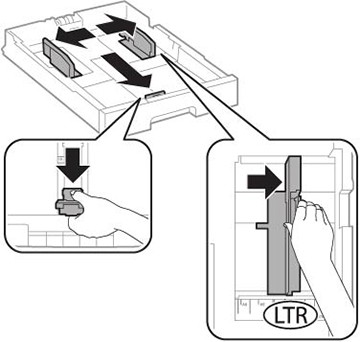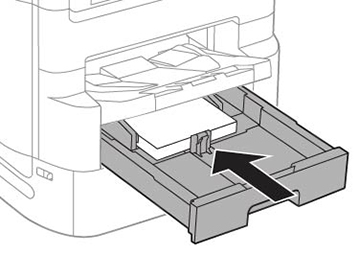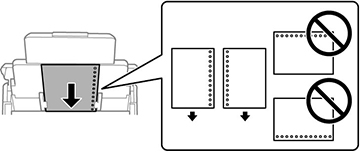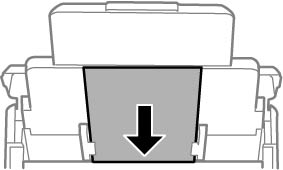You can load
paper up to 11 × 17 inches
(279 × 432 mm) in the paper cassettes and up
to 13 × 19 inches
(330 × 483 mm) in the rear paper feeder.
- Pull out a paper cassette.
- Slide the side edge guides in the paper cassette all the way out and set the front edge guide to the paper size you are using.
- Insert paper with the
glossy or printable side down. Then slide the edge guides against
the paper, but not too tightly.
Note: Make sure the paper is under the arrow mark on the edge guide.
- Keep the paper cassette flat as you insert it all the way.
- If you are loading
pre-punched paper, glossy paper, envelopes, or long paper in the
rear paper feeder, do one of the following:
- Load one sheet of pre-punched paper, short edge first as shown.
- Load sheets of paper, glossy or printable side up as shown.
- Load up to 10 envelopes, short edge first with the flap facing down and to the left, as shown.
- Load long paper by allowing paper to roll over as shown. Select the user-defined setting as the paper size setting.
- If the Paper Size Auto
Detect setting is enabled, your product automatically
detects the size of the paper you loaded. Otherwise, select the
 Paper
Setting button and select the size and type of paper
you loaded on the LCD screen as necessary.
Paper
Setting button and select the size and type of paper
you loaded on the LCD screen as necessary.
Always follow
these paper loading guidelines:
- Load only the recommended number of sheets.
- Load paper short edge first, no matter which way your document faces.
- Load letterhead or pre-printed paper top edge first.
- Do not load paper above the arrow mark inside the edge guides.
- Check the paper package for any additional loading instructions.
Caution:
Do not load the following papers; they
may cause paper jams, smears on the printout, or damage to the
printer.
- Papers that are wavy or damp
- Papers that have not dried after printing on one side
- Papers that are wadded or curled
- Papers that are torn, cut, or folded
- Papers that are too thick or thin
- Pre-printed papers printed by other inkjet printers, thermal transfer printers, page printers, or copiers
- Papers that are perforated
- Papers that have stickers
- Papers held together with tape, staples, or paper clips
- Envelopes with adhesive surfaces or windows







